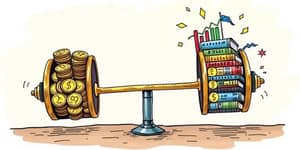
In today’s complex financial world, understanding the yield curve can be a game-changer for investors. When markets send subtle signals through bond yields, a careful observer can adapt portfolios to navigate uncertainty. This article dives into the phenomenon of an inverted yield curve, its driving forces, and how you can reshape your investment strategy to turn potential risks into opportunities.
An inverted yield curve occurs when short-term debt instruments have higher yields than longer-term bonds. Under normal conditions, lenders demand greater compensation for locking up capital over extended periods, producing an upward-sloping curve. Inversion flips this relationship, reflecting shifting expectations about the economy’s future health.
The concept of yield curve inversions gained prominence through the pioneering research of Campbell Harvey in his 1986 PhD thesis. Since then, investors and policymakers have watched this indicator closely, as past inversions have often presaged economic downturns.
Expectations Theory explains that when investors foresee lower short-term rates ahead, they pile into long-term bonds. This demand pushes up the bond prices and drives down their yields, triggering an inversion. Essentially, the market bets on future rate cuts to combat slowing growth.
Central bank actions and broader economic conditions also play a pivotal role. If a central bank raises rates aggressively to curb inflation, short-term yields can spike. Conversely, signals from policymakers about looming rate cuts can steepen or invert the curve.
Inflation dynamics further influence the curve’s shape. Periods of rising inflation may lift yields across the term spectrum, while disinflation—slower price growth—often coincides with yield curve inversions as markets anticipate easier monetary policy.
When the yield curve inverts, investors often recalibrate their portfolios to weather increased volatility and potential market downturns. Recognizing these shifts early can provide a crucial tactical edge.
Stock Markets: Inversion episodes frequently precede heightened equity market volatility and corrections. Defensive sectors—utilities, consumer staples, and healthcare—tend to display relative resilience during economic slowdowns. By increasing allocations to defensive sectors, investors can cushion the impact of equity drawdowns.
Bond Investments: An inverted curve offers enticing yields on short-term instruments but introduces reinvestment risk if rates ultimately fall. A popular approach is the barbell strategy, combining short-term and long-term bonds while underweighting mid-duration maturities. This structure balances attractive current income with the potential for capital appreciation when long-term yields decline.
Real Estate and Mortgage Markets: Lower long-term rates that follow an inversion can make mortgages more affordable, boosting homebuying demand. However, if a recession hits, property values may stagnate or decline. Homebuyers might consider locking in fixed-rate mortgages early, while real estate investors should prioritize properties with stable, long-term cash flows.
Yield curve inversions have a storied track record as recession predictors. Since the 1950s, every U.S. recession was preceded by an inversion of the spread between 10-year and shorter-term Treasury yields. These patterns underscore the curve’s reputation as a reliable warning signal.
Recent yield curve movements reflect a tug-of-war between inflation fears and growth concerns. Disinversion—a return to a normal upward slope—can herald stabilizing conditions and a potential market recovery. Investors should monitor key spread levels for signs of shifting economic sentiment.
Central bank policy remains a central driver. Rate cuts by the Federal Reserve or other major central banks can steepen the curve, improving prospects for equities and risk assets. Conversely, unexpected hawkish stances may keep the curve flat or inverted.
Historically, an inversion between the 10-year and 2-year yields has preceded every recession since 1955, making the spread one of the most watched metrics on Wall Street.
Yield curve inversions embody the market’s collective foresight, blending inflation expectations, monetary policy outlooks, and economic growth projections. While inversions often foreshadow downturns, understanding their mechanics empowers investors to adjust portfolios proactively.
By adopting defensive equity allocations and barbell bond structures, and watching for disinversion signals, you can position your investments to weather turbulent periods and seize opportunities when recovery begins. Stay informed, stay agile, and let the yield curve guide your strategic decisions in an ever-evolving financial landscape.
References













